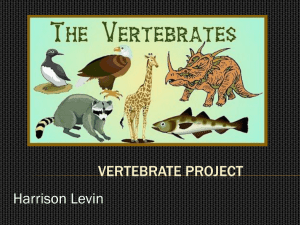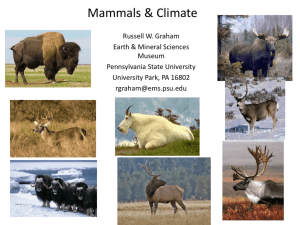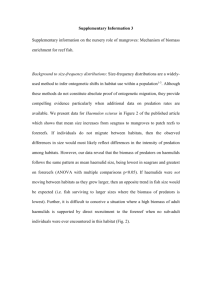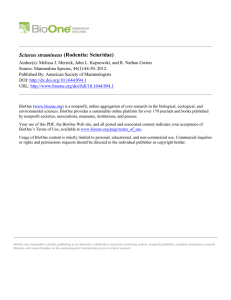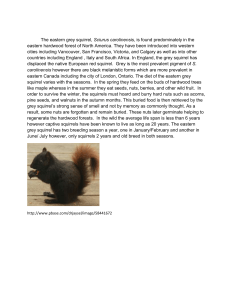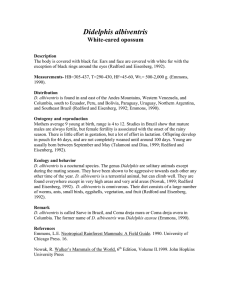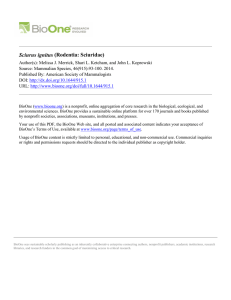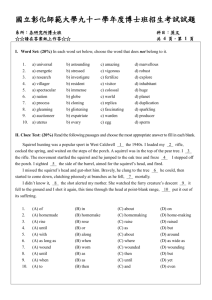Sciurus spadiceus
advertisement
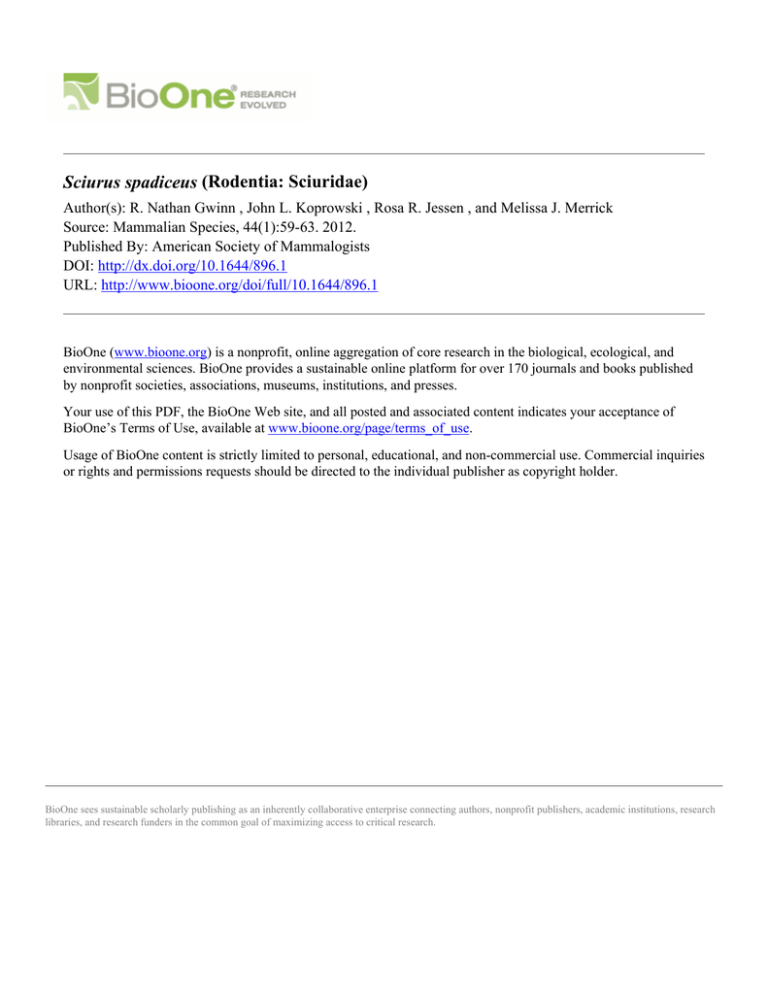
Sciurus spadiceus (Rodentia: Sciuridae) Author(s): R. Nathan Gwinn , John L. Koprowski , Rosa R. Jessen , and Melissa J. Merrick Source: Mammalian Species, 44(1):59-63. 2012. Published By: American Society of Mammalogists DOI: http://dx.doi.org/10.1644/896.1 URL: http://www.bioone.org/doi/full/10.1644/896.1 BioOne (www.bioone.org) is a nonprofit, online aggregation of core research in the biological, ecological, and environmental sciences. BioOne provides a sustainable online platform for over 170 journals and books published by nonprofit societies, associations, museums, institutions, and presses. Your use of this PDF, the BioOne Web site, and all posted and associated content indicates your acceptance of BioOne’s Terms of Use, available at www.bioone.org/page/terms_of_use. Usage of BioOne content is strictly limited to personal, educational, and non-commercial use. Commercial inquiries or rights and permissions requests should be directed to the individual publisher as copyright holder. BioOne sees sustainable scholarly publishing as an inherently collaborative enterprise connecting authors, nonprofit publishers, academic institutions, research libraries, and research funders in the common goal of maximizing access to critical research. 44(896):59–63 Sciurus spadiceus (Rodentia: Sciuridae) R. NATHAN GWINN, JOHN L. KOPROWSKI, ROSA R. JESSEN, AND MELISSA J. MERRICK School of Natural Resources and the Environment, University of Arizona, Tucson, AZ 85721-0001, USA; ngwinn@email.arizona. edu (RNG); squirrel@ag.arizona.edu (JLK); rjessen@email.arizona.edu (RRJ); mmerrick@email.arizona.edu (MJM) Abstract: Sciurus spadiceus Olfers, 1818, is a sciurid commonly known as the southern Amazon red squirrel. S. spadiceus is a large-bodied tree squirrel with a variable color pattern, but typically has a reddish brown dorsum, a dark midline, a white venter, and a brown and orange tail. S. spadiceus ranges from southern Colombia and Venezuela, south through Peru, western Brazil, Ecuador, and Bolivia in lowland rain forest. This species is listed as ‘‘Least Concern’’ by the International Union for Conservation of Nature and Natural Resources. Key Words: Venezuela Bolivia, Brazil, Colombia, Ecuador, lowland rain forest, Peru, South America, southern Amazon red squirrel, Ó 6 December 2012 American Society of Mammalogists Synonymy completed 01 July 2012 DOI: 10.1644/896.1 Sciurus spadiceus Olfers, 1818 Southern Amazon Red Squirrel Sc[iurus]. spadiceus Olfers, 1818:208. Type locality ‘‘Brasilia [Brazil],’’ restricted to ‘‘Cuyabá, Matto Grosso’’ by Hershkovitz (1959:346). Sciurus spaciceus Olfers, 1818:208. Incorrect subsequent spelling of S. spadiceus Olfers, 1818. Sciurus Langsdorffii Brandt, 1835:425, plate XI, figure 1. Type locality ‘‘Brasilia,’’ restricted to ‘‘Cuyaba [¼ Cuiabá], Mato Grosso, Brazil’’ by Wagner (1848:275). Sciurus pyrrhonotus Wagner, 1842:360. Type locality ‘‘Borba,’’ Rio Madeira, Amazonas, Brazil. Sciurus tricolor Tschudi, 1844:156, plate 11. Type locality ‘‘Maynas, lower Rı́o Huallaga, Peru.’’ Sciurus Morio Wagner, 1848:275. Type locality ‘‘Marabitanos, überhaupt vom Rio negro, zusammengebracht [Marabitanos, from the Rio Negro],’’ Amazonas, Brazil. Macroxus fumigatus Gray, 1867:428. Type locality ‘‘Upper Amazons, Brazil.’’ Macroxus brunneo-niger Gray, 1867:429. Type locality ‘‘Brazil (Castelnau).’’ Sciurus castus Thomas, 1903:488. Type locality ‘‘Chimate, [La Paz,] Bolivia, 688 W., 158 S. on the Upper Rio Beni. Alt 700 m.’’ Sciurus duida J. A. Allen, 1914:594. Type locality ‘‘Rio Cunucunumá (altitude 700 feet), base of Mount Duida, [Amazonas,] Venezuela,’’ dismissed as a composite specimen by Lawrence (1988). www.mammalogy.org Sciurus langsdorffii urucumus J. A. Allen, 1914:595. Type locality ‘‘Urucum (altitude 400 feet), Rio Paraguay (at mouth of Rio Tacuari), [Mato Grosso do Sul,] Brazil.’’ Sciurus langsdorffii steinbachi J. A. Allen, 1914:596. Type locality ‘‘Santa Cruz de la Sierra, [Santa Cruz,] Bolivia.’’ Sciurus (Urosciurus) pyrrhonotus taparius Thomas, 1926:635. Type locality ‘‘Urucurituba, Santarem,’’ Pará, Brazil. Sciurus pyrrhonotus juralis Thomas, 1926:636. Type locality ‘‘Jurua River [¼ Rio Jurua],’’ Acre or Amazonas, Brazil. Urosciurus nigratus Pinto, 1931:309. Type locality ‘‘Rio Juruá, Amazonas, Brazil.’’ Hadrosciurus pyrrhonotus purusianus Moojen, 1942:31. Type locality ‘‘Lago Aiapuá, Baixo Pur ús, Estado do Amazonas,’’ Brazil. Hadrosciurus langsdorffii rondoniae Moojen, 1942:39. Type locality ‘‘Cabeceiras do Rio Aripuanã, Rondonia, Mato-Grosso,’’ Brazil. CONTEXT AND CONTENT. Order Rodentia, suborder Sciuromorpha, superfamily Sciuroidea, family Sciuridae, subfamily Sciurinae, and tribe Sciurini. S. spadiceus is closely related to and phenotypically similar to S. igniventris; both species are members of the subgenus Urosciurus (Patton 1984). Three subspecies of S. spadiceus are recognized (Hershkovitz 1959; Patton 1984; Thorington and Hoffmann 2005): S. s. spadiceus Olfers, 1818:208. See above. S. s. steinbachi J. A. Allen, 1914:596. See above; langsdorffii Brandt is a synonym. S. s. tricolor Tschudi, 1844:156. See above. MAMMALIAN SPECIES 60 44(896)—Sciurus spadiceus DIAGNOSIS Sciurus spadiceus is easily distinguished from most other sciurids that occur in its range (Eisenberg 1989; Eisenberg and Redford 1999; Emmons and Feer 1990). Members of the genus Microsciurus (dwarf squirrels) and Sciurillus pusillus (Neotropical pygmy squirrel) are much smaller (,30% of the body size of S. spadiceus) and differ in cranial morphology. Congeners that are sympatric with S. spadiceus include S. aestuans (Guianan squirrel) and S. gilvigularis (yellowthroated squirrel), which are much smaller (,50% the body size) with a brownish to agouti pelage. S. spadiceus differs from the smaller (,60% of the body size) S. ignitus (Bolivian squirrel) and S. sanborni (Sanborn’s squirrel) in pelage coloration, with the latter species having sparsely haired ears, a gray to olive brown dorsum, a yellow to orange venter, and a banded tail. S. spadiceus is slightly smaller (about 90% of the body size) and lacks the grizzled yellowish dorsum of S. flammifer (fiery squirrel). S. spadiceus is similar to S. pyrrhinus (Junı́n red squirrel) in overall coloration, but differs in that S. spadiceus is larger (about 110% of body size) and has a tail longer than the body. Sciurus spadiceus is very similar to the congeneric S. igniventris (the northern Amazon red squirrel). The 2 species differ in cranial morphology; S. spadiceus has a long-muzzled and narrow skull, whereas the skull of S. igniventris is broad with a shorter rostrum (Eisenberg 1989; Patton 1984; Thomas 1900). An analysis of measurements (mm) taken on animals from 3 sites in Peru resulted in a mean skull length of 69.75, mean rostral width of 12.07, and mean rostral length of 29.64 for S. spadiceus (n ¼ 71) compared to 63.24, 15.29, and 25.83, respectively, for S. igniventris (n ¼ 66—Patton 1984). S. spadiceus and S. igniventris are very similar in size and pelage coloration but differ in that S. igniventris lacks orange patches behind its ears as well as orange fur on the tops of its feet (Eisenberg and Redford 1999; Patton 1984). Sciurus spadiceus spadiceus possesses a dorsum grizzled with pale yellowish and dusky fur, ochraceous buff underparts, and fur washed with reddish orange on cheeks and head. S. s. steinbachi is a larger form that is paler with upper parts grizzled with pale yellowish and dusky fur and ochraceous buff underparts, washed with yellowish on cheeks and head. S. s. tricolor has a dark brown to blackish dorsum washed with ochre and a venter of pale yellow. GENERAL CHARACTERS Sciurus spadiceus is a large-bodied tree squirrel with an elongated tail (Fig. 1). Mean (range) of external measurements (mm) of adult S. spadiceus were: total length, 524.5 (475.0– 628.0); length of tail, 268.8 (240.0–340.0); length of hind foot, 65.3 (59.0–71.0); length of ear, 32.6 (30.0–34.0—Eisenberg 1989; Eisenberg and Redford 1999; Hayssen 2008; Patton Fig. 1.—An adult Sciurus spadiceus from western Brazilian Amazon in the Mamiraua Reserve between the Solimones River and the Japura River. Photograph by William Quatman used with permission. 1984; Thomas 1903). Mean (range) body mass (g) was 615 (570–660—Eisenberg and Redford 1999; Hayssen 2008). The skull of S. spadiceus is relatively narrow and has a prominent rostrum (Fig. 2). Mean (range) cranial measurements (mm) were: length of skull, 68.00 (63.30–71.23); basilar length of Hensel, 54.00 (50.30–56.47); mastoid breadth, 26.48 (25.67– 26.85); width of least interorbital constriction behind the postorbital process, 19.88 (19.09–20.44); least interorbital breadth anterior to postorbital process, 21.80 (20.90–22.54); zygomatic breadth, 39.08 (37.19–40.55); rostral length, 28.79 (26.21–30.51); length of nasal, 21.94 (20.42–23.41); rostral width, 11.76 (10.00–12.57); length of diastema, 20.98 (18.83– 22.38); length of maxillary toothrow, 10.34 (9.79–10.74); palatal width at M1, 6.99 (6.70–7.18); mesopterygoid fossa width, 5.76 (5.59–6.07); basisoccipital width at junction with basisphenoid, 8.73 (7.23–9.12); bullar length, 10.52 (10.12– 10.99); bullar height, 9.77 (9.46–10.18); cranial depth, 27.19 (25.00–28.01); ramus height from angular to coronoid process, 25.19 (23.59–26.15); length of ramus, 42.37 (37.93–46.02); ramus height at P4, 13.10 (12.03–13.82—Patton 1984). Sexual dimorphism is not apparent in S. spadiceus (Patton 1984). DISTRIBUTION Sciurus spadiceus is found from southern Colombia and Venezuela, south through the lowland forests of Peru, Ecuador, western Brazil, and Bolivia, often extending into the foothills of the Andes (Fig. 3; Eisenberg 1989; Eisenberg and Redford 1999). S. s. spadiceus was collected in the western Brazilian state of Matto Grosso and appears to be found primarily in Brazil; S. s. steinbachi was collected and is found primarily in Bolivia; S. s. tricolor was originally collected and appears to be found primarily in Peru. Accurate geographical 44(896)—Sciurus spadiceus MAMMALIAN SPECIES 61 Eisenberg and Redford 1999; Thomas 1900, 1903). In addition to the prominent coloration, tails are noticeably elongated and exceed the body length. Mammae count is 8 in females (Thomas 1900). The relatively long snout (compared to the similar S. igniventris) does not convey mechanical advantage when forces generated are considered (Velhagen and Roth 1999). The dental formula for S. spadiceus is i 1/1, c 0/0, p 1/1, m 3/3, total 20. ONTOGENY AND REPRODUCTION The reproductive behavior and timing of Sciurus spadiceus is unknown. Young squirrels have been seen in Peru in early June, suggesting that breeding occurs at least in the autumn months of the Southern Hemisphere and possibly around August in Bolivia, producing a litter of 2–4 (Anderson 1997). ECOLOGY Fig. 2.—Dorsal, ventral, and lateral views of skull and lateral view of mandible of an adult male Sciurus spadiceus (Field Museum of Natural History specimen 21545) from Porto Velho, Brazil. Occipitonasal length is 1.5 cm. Photograph by Bruce Patterson used with permission. boundaries that separate each of these subspecies remain unclear. No fossils of S. spadiceus are known. FORM AND FUNCTION Sciurus spadiceus has a variable pelage but typically has a reddish brown dorsum with orange patches behind its ears, a dark midline, and a white venter. The feet often have black fur on the dorsal surface, and the tail is dark brown at its base with orange fur on the distal two-thirds. Melanistic specimens have been collected for this species, and thus black morphs do occur (Cabrera 1961; Eisenberg 1989; Sciurus spadiceus lives in the foothill forests of the Andes and persists in some disturbed forests (Mena and Medellı́n 2010); however, S. spadiceus is most common in lowland rain forests of the Amazon Basin (Eisenberg 1989; Eisenberg and Redford 1999; Solari et al. 2006), which are subject to wet and dry seasons that include seasonal flooding (Butt et al. 2008; Haugaasen and Peres 2007). Given these conditions, S. spadiceus remains in the upper canopy of the forest when the ground and understory are inundated with water and does not abandon flooded areas (Haugaasen and Peres 2005, 2007). However, S. spadiceus is most often seen on the ground, in low undergrowth, or in palm trees (Emmons and Feer 1990). Lowland Amazon forests are incredibly diverse in tree species (Gentry 1992; Terborgh and Andresen 1998), and S. spadiceus specializes in the thick, hard-shelled nuts common to many of the tree species of this ecosystem (Emmons 1984). In the western Amazon region, S. spadiceus specializes on large nuts with thick, hard endocarps; fruit from 4 large-seeded genera (Astrocaryum, Attalea, Scheelea, and Dipteryx) provide the vast majority of this species’ diet (Cintra and Horna 1997; Emmons 1984; Peres 1994; Peres and Baider 1997). S. spadiceus also consumes clay and soil on rare occasions (Brightsmith and Munoz-Najar 2004). The difference in rostral length between S. spadiceus and the phenotypically similar and often syntopic S. igniventris suggests an ecological difference between the 2 species, but this remains unconfirmed (Hershkovitz 1959; Patton 1984). It has been stated that sciurids represent 50% of the biomass in the Neotropics (Peres 1999). Population densities and biomass for S. spadiceus in different parts of its range are 2.4–12.2 individuals/10 km or 3.8–6.6 individuals/km2 and 3.0–9.8 kg/km2, respectively (Aquino 2005; Emmons 1984; Endo et al. 2010; Gómez et al. 2003; Peres 1999). Endoparasites include the coccidian Eimeria damnosa, which may MAMMALIAN SPECIES 62 44(896)—Sciurus spadiceus (North and South American species) is more closely related to the Neotropical genus of dwarf squirrels (Microsciurus) than to the Neotropical genus of pygmy squirrels (Sciurillus— Hafner et al. 1994). CONSERVATION Fig. 3.—Geographic distribution of Sciurus spadiceus. cause death, and unidentified species of Giardia and Trypanosoma (Lainson et al. 2004, 2005). Ocelots (Leopardus pardalis) and jaguars (Panthera onca) are known predators of S. spadiceus (Emmons 1987). BEHAVIOR Sciurus spadiceus is diurnal, nonterritorial, and remains active year-round. The loud gnawing to access the endosperm within the thickened coverings of various rain-forest fruits and nuts is an excellent indicator of the presence of S. spadiceus. Several individuals have been observed feeding in the same tree, leaving conspicuous feeding sign at the tree’s base. Nuts are often cached in the ground and several individuals can easily remove hundreds of nuts from a palm. S. spadiceus does not travel in the forest canopy and instead descends to the ground and runs away in the undergrowth when alarmed. S. spadiceus rarely calls but when threatened produces an alarm call that sounds much like a sneeze followed by a series of chatters and chucks (Eason 2010; Emmons and Feer 1990). Home ranges are estimated to be 25–50 ha (Haugaasen and Peres 2005). GENETICS The diploid number (2n) for Sciurus spadiceus is 40 with a fundamental number (FN) of 76, with all autosome pairs being biarmed (Lima and Langguth 2002). In a genetic analysis of New World tree squirrels it was determined, based on a locus by locus protein analysis, that the genus Sciurus Sciurus spadiceus is listed as ‘‘Least Concern’’ on the International Union for Conservation of Nature and Natural Resources Red List of Threatened Species (Amori et al. 2008). The species has a large geographic range and does not appear to be declining at a significant rate (Amori et al. 2008). Habitat destruction is a significant threat to the survival of S. spadiceus as well as all other mammals in the Amazon Basin (Amori et al. 2008). Individuals of S. spadiceus are able to persist in disturbed forest but the long-term impacts are unknown (Mena and Medellı́n 2010). Coupled with deforestation is hunting for bush meat, which has been observed for this species in Ecuador and Peru (Emmons 1984). Dogs are trained to hunt S. spadiceus (Jernigan 2009) and although it is not a preferred item for hunters, numbers and biomass of S. spadiceus decrease demonstrably in areas where this largebodied squirrel is hunted for food (Bodmer 1995; Emmons 1984; Endo et al. 2010; Mena-Valenzuela 1998). Camera traps and feeding sign can be used to document the presence of S. spadiceus (Tobler et al. 2008). The conservation of S. spadiceus would be greatly improved by greater knowledge of this squirrel’s basic ecology, microhabitat affinities, and other aspects of its natural and life history. ACKNOWLEDGMENTS We thank Dr. B. Patterson and the Field Museum of Natural History in Chicago, Illinois, for the skull photos and M. J. Merrick for producing the distribution map. We also thank Dr. T. Holmes for helpful comments used in the revision of the manuscript. LITERATURE CITED ALLEN, J. A. 1914. New South American Sciuridae. Bulletin of the American Museum of Natural History 33:585–597. AMORI, G., J. L. KOPROWSKI, AND L. ROTH. 2008. Sciurus spadiceus. In International Union for Conservation of Nature and Natural Resources Red list of threatened species. Version 2010.1. www. iucnredlist.org, accessed 18 May 2010. ANDERSON, S. 1997. Mammals of Bolivia: taxonomy and distribution. Bulletin of the American Museum of Natural History 231:1–652. AQUINO, R. 2005. Alimentación de mamı́feros de caza en los aguajales de la Reserva Nacional de Pacaya-Samiria (Iquitos, Perú). Revista Peruana de Biologı́a 12:417–425. BODMER, R. E. 1995. Managing Amazonian wildlife: biological correlates of game choice by detribalized hunters. Ecological Applications 5:872–877. BRANDT, J. F. 1835. Mammalium rodentium exoticum novorum vel minus rite cognitorum Musei Academici Zoologici descriptiones et icones. Mémoires l’Académie Impériale des Sciences de SaintPétersbourg, Série 6, 3(2):425–436. 44(896)—Sciurus spadiceus MAMMALIAN SPECIES BRIGHTSMITH, D. J., AND R. A. MUNOZ-NAJAR. 2004. Avian geophagy and soil characteristics in southeastern Peru. Biotropica 36:534– 543. BUTT, N., Y. MALHI, O. PHILLIPS, AND M. NEW. 2008. Floristic and functional affiliations of woody plants with climate in western Amazonia. Journal of Biogeography 35:939–950. CABRERA, A. 1961. Catálogo de los mamı́feros de América del Sur. Revista Museo Argentino Ciencias Naturales (Ciencias Zoológicas) 4:309–732. CINTRA, R., AND V. HORNA. 1997. Seed and seedling survival of the palm Astrocaryum murumuru and the legume tree Dipteryx micrantha in gaps in Amazonian forest. Journal of Tropical Ecology 13:257–277. EASON, P. 2010. Alarm signaling in a facultatively social mammal, the southern Amazon red squirrel Sciurus spadiceus. Mammalia 74:1–3. EISENBERG, J. F. 1989. Mammals of the Neotropics. Vol. 1. The northern Neotropics: Panama, Colombia, Venezuela, Guyana, Suriname, French Guiana. University of Chicago Press, Chicago, Illinois. EISENBERG, J. F., AND K. H. REDFORD. 1999. Mammals of the Neotropics. Vol. 3. The central Neotropics: Ecuador, Peru, Bolivia, Brazil. University of Chicago Press, Chicago, Illinois. EMMONS, L. H. 1984. Geographic variation in densities and diversities of non-flying mammals in Amazonia. Biotropica 16:210–222. EMMONS, L. H. 1987. Comparative feeding ecology of felids in a Neotropical rainforest. Behavioral Ecology and Sociobiology 20:271–283. EMMONS, L. H., AND F. FEER. 1990. Neotropical rainforest mammals: a field guide. University of Chicago Press, Chicago, Illinois. ENDO, W., ET AL. 2010. Game vertebrate densities in hunted and nonhunted forest sites in Manu National Park, Peru. Biotropica 42:251–261. GENTRY, A. H. 1992. Tropical forest biodiversity; distributional patterns and their conservational significance. Oikos 63:19–28. G ÓMEZ, H., R. B. WALLACE, G. AYALA, AND F. ESPINOZA. 2003. Densidad de la ardilla roja amazónica (familia Sciuridae, Sciurus spadiceus) en el valle del rı́o Tuichi (Parque Nacional y Area Natural de Manejo Integrado Madidi, La Paz, Bolivia). Ecologı́a en Bolivia 38:79–88. GRAY, J. E. 1867. Synopsis of the species of American squirrels in the collection of the British Museum. Annals and Magazine of Natural History 3:415–434. HAFNER, M. S., L. J. BARKLEY, AND J. M. CHUPASKO. 1994. Evolutionary genetics of New World tree squirrels (tribe Sciurini). Journal of Mammalogy 75:102–109. HAUGAASEN, T., AND C. A. PERES. 2005. Vertebrate responses to fruit production in Amazonian flooded and unflooded forests. Journal of Tropical Ecology 21:133–145. HAUGAASEN, T., AND C. A. PERES. 2007. Vertebrate responses to fruit production in Amazonian flooded and unflooded forests. Biodiversity and Conservation 16:4165–4190. HAYSSEN, V. 2008. Patterns of body and tail length and body mass in Sciuridae. Journal of Mammalogy 89:852–873. HERSHKOVITZ, P. 1959. Nomenclature and taxonomy of the Neotropical mammals described by Olfers, 1818. Journal of Mammalogy 40:337–353. JERNIGAN, K. A. 2009. Barking up the same tree: a comparison of ethnomedicine and canine ethnoveterinary medicine among the Aguaruna. Journal of Ethnobiology and Ethnomedicine 5:33–42. LAINSON, R., M. C. O. BRIGIDO, AND F. T. SILVEIRA. 2004. Blood and intestinal parasites of squirrels (Rodentia: Sciuridae) in Amazonian Brazil. Memórias do Instituto Oswaldo Cruz 99:577–579. LAINSON, R., M. C. O. BRIGIDO, AND F. T. SILVEIRA. 2005. Parasites of the squirrel Sciurus spadiceus (Rodentia: Sciuridae) from Amazonian Brasil, with particular reference to Eimeria damnosa n. sp (Apicomplexa: Eimeriidae). Parasite 12:305–315. LAWRENCE, M. A. 1988. The identity of Sciurus duida J. A. Allen (Rodentia: Sciuridae). American Museum Novitates 2919:1–8. LIMA, J. F. D., AND A. LANGGUTH. 2002. Karyotypes of Brazilian squirrels: Sciurus spadiceus and Sciurus alphonsei (Rodentia, Sciuridae). Folia Zoologica 51:201–204. MENA, J. L., AND R. A. MEDELLÍN. 2010. Small mammal assemblages in a disturbed tropical landscape at Pozuzo, Peru. Mammalian Biology 75:83–91. 63 MENA-VALENZUELA, P. 1998. Importancia económica de los mamı́feros en tres etnias del Ecuador. Pp. 199–207 in Biologı́a, sistemática y conservación de los mamı́feros del Ecuador (D. Tirira S., ed.). Publicación Especial 1. Museo de Zoologı́a, Centro de Biodiversidad y Ambiente, Pontifica Universidad Católica del Ecuador, Quito, Ecuador. MOOJEN, J. 1942. Sobre os ‘‘ciurı́deos’’ das coleções do Museu Nacional, do Departamento de Zoologia de São Paulo e do Museu Paraense Emı́lio Goeldi. Boletim do Museu Nacional (Rio de Janeiro), Nova Série, Zoologia 1:1–52. OLFERS, I. VON. 1818. Bemerkungen zu Illiger’s Ueberblick der S äugthiere nach ihrer Vertheilung über die Welttheile, rücksichtlich der Südamericanischen Arten (Species). Abhandlung X in W. L. Eschwege, Journal von Brasilien, odor vermischte Nachrichten aus Brasilien, auf wissenschaftlichen Reisen gesammelt. Heft 2 in F. Bertuch (ed.), Neue Bibliothek der wichtigsten Reisebeschreibungen zur Erweiterung der Erd- und Völkerkunde, Band 5:192–237. Weimar, Germany. PATTON, J. L. 1984. Systematic status of the large squirrels (subgenus Urosciurus) of the western Amazon Basin. Studies on Neotropical Fauna and the Environment 19:53–72. PERES, C. A. 1994. Composition, density, and fruiting phenology of arborescent palms in an Amazonian terra firme forest. Biotropica 26:285–294. PERES, C. A. 1999. The structure of nonvolant mammal communities in different Amazonian forest types. Pp. 564–581 in Mammals of the Neotropics. Vol. 3. The central Neotropics: Ecuador, Peru, Bolivia, Brazil. University of Chicago Press, Chicago, Illinois. PERES, C. A., AND C. BAIDER. 1997. Seed dispersal, spatial distribution and population structure of Brazilnut trees (Bertholletia excelsa) in southeastern Amazonia. Journal of Tropical Ecology 13:595– 616. PINTO, O. M. 1931. Ensaio sobre a fauna de Sciurı́deos do Brasil. Revista Museu do Paulista, São Paulo 17:263–321. SOLARI, S., V. PACHECO, L. LUNA, P. M. VELAZCO, AND B. D. PATTERSON. 2006. Mammals of the Manu Biosphere Reserve. Fieldiana: Zoology (New Series) 110:13–22. TERBORGH, J., AND E. ANDRESEN. 1998. The composition of Amazonian forests: patterns at local and regional scales. Journal of Tropical Ecology 14:645–664. THOMAS, O. 1900. On giant squirrels from the Amazonian region. Annals and Magazine of Natural History, Series 7, 6:137–139. THOMAS, O. 1903. New forms of Sciurus, Oxymycterus, Kannabateomys, Proechimys, Dasyprocta, and Caluromys from South America. Annals and Magazine of Natural History, Series 7, 11:487–493. THOMAS, O. 1926. On some mammals from the middle Amazons. Annals and Magazine of Natural History, Series 9, 17:635–639. THORINGTON, R. W., JR., AND R. S. HOFFMANN. 2005. Family Sciuridae. Pp. 754–818 in Mammal species of the world: a taxonomic and geographic reference (D. E. Wilson and D. M. Reeder, eds.). 3rd ed. Johns Hopkins University Press, Baltimore, Maryland. TOBLER, M. W., S. E. CARRILLO-PERCASTEGUI, R. LEITE PITMAN, R. MARES, AND G. POWELL. 2008. An evaluation of camera traps for inventorying large- and medium-sized terrestrial rainforest mammals. Animal Conservation 11:169–178. TSCHUDI, J. J. 1844. Therologie. Pp. 1–262 in Untersuchungen über die Fauna Peruana (J. J. von Tschudi, ed.). Scheitlin and Zollikofer, St. Gallen, Switzerland. VELHAGEN, W. A., AND V. L. ROTH. 1999. Scaling of the mandible in squirrels. Journal of Morphology 232:107–132. WAGNER, J. A. 1842. Diagnosen neuer Arten brasilischer Säugthiere. Archiv für Naturgeschicthe, Wiegmann, Berlin 8:356–362. WAGNER, J. A. 1848. Beiträge zur Kenntniss der Säugthiere Amerika’s. Abhandlungen der Mathematisch—Physikalischen Classe der Königlich Bayerischen Akademie der Wissenschaften, Neue Folge 5:271–285. Associate Editor of this account was ERIC A. RICKART. JIM PATTON reviewed the synonymy. Editor was MEREDITH J. HAMILTON.
